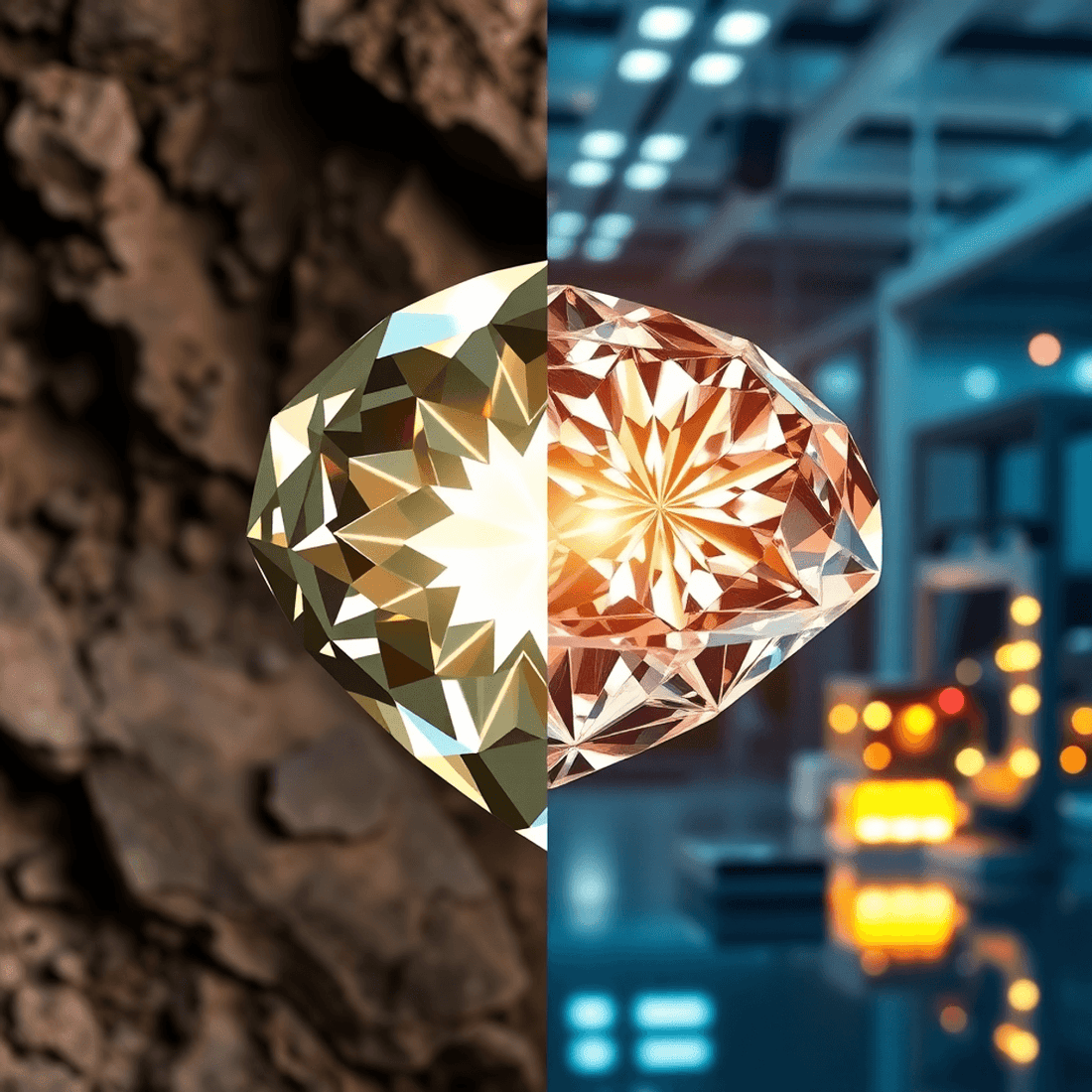
The Difference Between Lab-Grown and Natural Diamonds Explained
As a jeweler in New York's Diamond District for over two decades, I've witnessed a fascinating evolution in the diamond industry. The emergence of lab-grown diamonds has sparked countless conversations at my counter, with clients eager to understand what sets these stones apart from their natural counterparts.
Natural diamonds tell a story billions of years in the making - formed deep within Earth's mantle through intense heat and pressure. Lab-grown diamonds, created in controlled settings using advanced technology, represent modern innovation in gemstone production.
Both options present unique advantages:
-
Natural Diamonds
- Earth-created over billions of years
- Valued for their rarity
- Each stone tells a unique geological story
-
Lab-Grown Diamonds
- Created in controlled environments
- More affordable option
- Technologically advanced production
Understanding these differences helps you make an informed decision that aligns with your values, budget, and preferences.
Key Differences Between Lab-Grown and Natural Diamonds You Should Know
1. Formation Process: Nature vs. Nurture
As a jeweler in NYC's Diamond District, I've witnessed countless customers fascinated by the distinct origins of natural and lab-grown diamonds. Let me share what makes each unique.
Natural Diamonds: A Journey Through Time
Natural diamonds tell an incredible story of time and pressure deep within Earth's mantle. These precious gems form 150 kilometers beneath the surface through:
- Intense pressure: 725,000 pounds per square inch
- Extreme heat: 2,200°F to 2,700°F
- A remarkable journey spanning 1-3 billion years
The raw power of nature transforms pure carbon into these stunning crystals, pushing them toward the surface through volcanic activity.
Lab-Grown Diamonds: Human Innovation
Lab-grown diamonds emerge from controlled environments that replicate these natural conditions. In my experience working with both varieties, the scientific process involves:
- High-pressure, high-temperature (HPHT) method
- Creates diamonds in specialized presses
- Reaches temperatures up to 2,700°F
- Applies pressure exceeding 870,000 psi
- Chemical vapor deposition (CVD)
- Uses heated gases in vacuum chambers
- Forms diamonds layer by layer
- Takes 6-10 weeks to complete
The resulting gems share identical chemical compositions - pure carbon arranged in a crystalline lattice structure. I've examined countless specimens under magnification, and both types exhibit the same fundamental properties that make diamonds so special.
What truly sets them apart is their timeline. While natural diamonds require billions of years to form, lab-grown diamonds emerge in a matter of weeks. This accelerated process doesn't compromise quality but reflects human innovation in recreating nature's masterpiece.
2. Chemical Composition: The Carbon Connection
At their core, both lab-grown and natural diamonds share an identical chemical composition - pure carbon atoms arranged in a perfect crystalline structure. As a professional jeweler in NYC's Diamond District, I've examined countless diamonds under sophisticated equipment, and the atomic arrangement remains consistent regardless of origin.
The fascinating aspect lies in the presence of trace elements:
- Natural Diamonds contain nitrogen impurities that developed during their formation deep within Earth's mantle
- Lab-Grown Diamonds can be engineered with controlled nitrogen levels, affecting their final color grade
These tiny variations in chemical makeup create distinct "fingerprints" that help identify a diamond's origin:
- Type IaA/B: Most natural diamonds fall into this category, containing grouped nitrogen atoms
- Type IIa: Extremely pure diamonds with minimal nitrogen content
- Type IIb: Rare specimens containing boron, resulting in a bluish tint
Through my years of experience, I've noticed lab-grown diamonds typically display different types of inclusions compared to their natural counterparts. While natural diamonds might show crystal inclusions or growth patterns formed over millions of years, lab-grown diamonds often contain metallic inclusions from the growth chamber.
The beauty of modern technology allows us to create diamonds that are chemically identical to those formed in nature. Both types will test positive as genuine diamonds using traditional jeweler's tools because, at the molecular level, they're both pure carbon crystals with the same basic chemical properties.
3. Optical Properties: Seeing Beyond the Surface
One of the most fascinating aspects of diamonds that I've encountered countless times in my jewelry store is their optical properties. At first glance, lab-grown and natural diamonds look exactly the same - they sparkle, reflect light, and display the same fire and brilliance that makes diamonds so captivating.
The Visual Challenge
- Both types have the same ability to bend light (refractive index)
- They both scatter light in the same way (light dispersion)
- Both types exhibit similar colors and brightness (fire, brilliance, scintillation)
- Under certain lighting conditions, they create identical rainbow effects
As a professional jeweler, I can't tell lab-grown and natural diamonds apart just by looking at them - trust me, I've tried! They look identical because they have the same crystal structure and chemical composition.
Advanced Detection Methods
To differentiate between lab-grown and natural diamonds, experts use advanced testing methods such as:
- Specialized spectroscopy equipment
- Photoluminescence analysis
- Examination of growth patterns
- Evaluation of crystal strain patterns
These tests can reveal subtle differences in:
- Growth sector patterns
- Crystal strain characteristics
- Fluorescence responses
- Trace element distributions
Through my years of experience in NYC's Diamond District, I've learned to rely on certified gemological laboratories equipped with these advanced testing instruments. These labs can detect the unique "fingerprints" that differentiate lab-grown from natural diamonds - subtle characteristics invisible to the naked eye but revealing under specialized equipment.
The Testing Process
The testing process requires:
- Professional-grade equipment
- Certified gemologist expertise
- Multiple analytical approaches
- Detailed documentation
Interestingly, some advanced testing methods used in diamond differentiation also find applications in other fields. For instance, the tuning of silicon nitride stoichiometry for visible light is a notable example where similar optical principles are applied. Moreover, research into thermotropic materials demonstrates how light scattering and fluorescence response can be utilized in innovative ways beyond gemstone analysis.
4. Ethical Considerations: Choosing a Conscience-Friendly Option
As a jeweler in NYC's Diamond District, I've witnessed a growing awareness of ethical considerations in diamond purchases. The ethical implications of diamond choices extend beyond personal preferences to global environmental and social impacts.
Environmental Impact:
- Natural diamond mining can disturb approximately 100 square feet of land and move 250 tons of earth for a single carat
- Lab-grown diamonds produce about 85% less carbon emissions per carat
- Mining operations often require extensive water usage and can lead to soil erosion
Social Considerations:
- Traditional diamond mining has historical links to:
- Labor concerns in certain regions
- Community displacement
- Resource conflicts in mining areas
Lab-grown diamonds present an alternative that addresses these ethical concerns. These diamonds emerge from controlled laboratory environments, eliminating the need for extensive mining operations and reducing potential social conflicts.
Industry Response:
- Natural diamond industry has implemented:
- Kimberley Process certification
- Ethical sourcing initiatives
- Community development programs
- Lab-grown sector emphasizes:
- Transparent supply chains
- Reduced environmental footprint
- Sustainable production methods
The choice between natural and lab-grown diamonds often reflects personal values regarding environmental stewardship and social responsibility. Many of my clients appreciate having options that align with their ethical principles while maintaining the same physical and chemical properties of traditional diamonds.
5. Value and Rarity: Understanding Market Perceptions
Natural diamonds hold a distinct position in the market due to their inherent scarcity. As a jeweler in NYC's Diamond District, I've observed how this rarity directly influences their market value:
- Geological Uniqueness: Each natural diamond tells a 3-billion-year story of Earth's history through its crystalline structure
- Limited Supply: Natural diamond deposits are finite, with new discoveries becoming increasingly rare
- Market Dynamics: The controlled release of natural diamonds helps maintain their value stability
Lab-grown diamonds present a different value proposition:
- Production Scalability: Manufacturing capabilities can adjust to meet market demand
- Price Accessibility: typically 30-40% lower than natural diamonds
- Value Retention: Market prices continue adjusting as production technology advances
The rarity factor creates notable price differences:
"A 2-carat natural diamond might sell for $20,000, while a lab-grown diamond of identical specifications could be priced at $8,000" - Mike Nekta's pricing experience
Investment Considerations:
- Natural diamonds maintain stronger resale value
- Limited supply supports long-term value preservation
- Historical price appreciation trends favor natural stones
The market recognizes both options as genuine diamonds, yet their value trajectories differ based on their origin stories. Natural diamonds benefit from their non-renewable status, while lab-grown diamonds offer immediate cost advantages.
6. Consumer Decision Making: Balancing Personal Preferences and Practical Factors
As a jeweler in NYC's Diamond District, I've guided countless couples through their diamond selection journey. The choice between lab-grown and natural diamonds often comes down to personal values and practical considerations.
Key Decision Factors to Consider:
-
Budget Alignment
- Natural diamonds typically cost 30-40% more than lab-grown equivalents
- Lab-grown options allow for larger carat weights at the same price point
- Investment potential differs between the two options
-
Personal Values
- Environmental impact consciousness
- Traditional vs. modern perspectives on diamond origin
- Cultural and family expectations
-
Style Preferences
- Identical visual characteristics
- Similar durability and wear resistance
- Equal brilliance and fire in both types
Professional Insights:
I've noticed a growing trend among younger buyers who prioritize sustainability and ethical sourcing. These consumers often lean toward lab-grown diamonds, valuing their minimal environmental impact. This shift is part of a larger movement towards investing in sustainable jewelry, which includes a preference for lab-grown diamonds.
On the other hand, traditional buyers, particularly those seeking heirloom pieces, tend to prefer natural diamonds for their geological significance and historical value. Interestingly, I've also observed a rise in interest among younger consumers towards vintage jewelry, which offers a unique blend of style and history.
Making Your Decision:
- Research both options thoroughly
- Consider your long-term satisfaction
- Discuss preferences with your partner
- Set clear priorities for:
- Size vs. budget
- Origin importance
- Environmental impact
- Investment potential
Remember: Both choices offer certified, high-quality diamonds. The right decision depends on your unique circumstances and values.
Choosing Your Perfect Diamond: A Personal Journey
The choice between lab-grown and natural diamonds reflects your unique story and values. As a jeweler in NYC's Diamond District, I've guided countless couples through this decision. Each option has its own advantages:
- Natural diamonds carry billions of years of Earth's history, offering unmatched rarity and traditional value
- Lab-grown diamonds provide ethical clarity and budget-friendly accessibility without compromising on beauty
Your perfect diamond is waiting for you - whether it came from deep within the Earth or was created through modern innovation. The key? Trust your instincts while staying informed about:
- Formation processes
- Chemical composition
- Optical properties
- Ethical considerations
- Market value
- Personal priorities
Remember: Both choices are equally valid. The "right" decision is the one that resonates with your values and brings joy to your special moment. As your trusted jeweler, I'm here to help you navigate this choice with confidence and clarity.
Ready to explore your diamond options? Visit our showroom in NYC's Diamond District - where expertise meets understanding.
